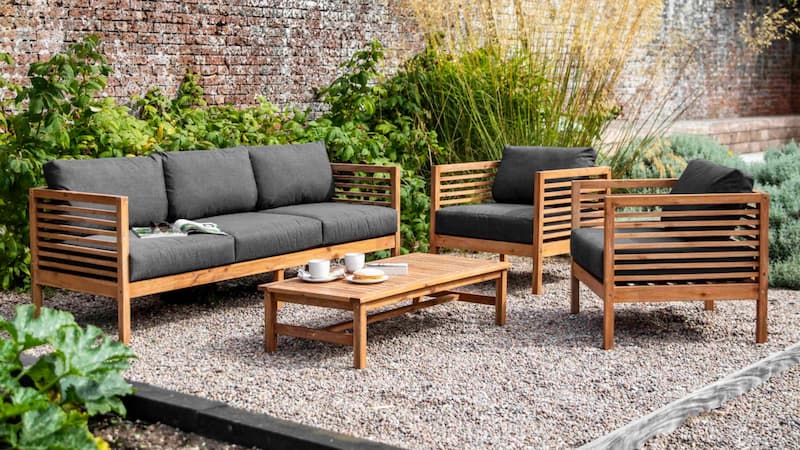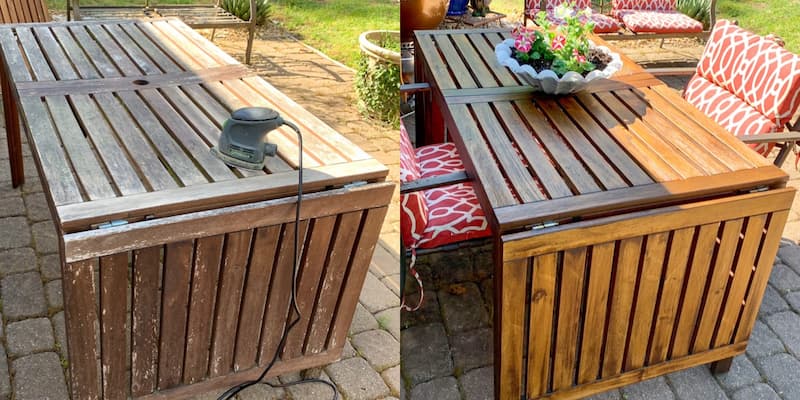First, how to protect outdoor wood furniture?
By painting, sealing, varnishing, moving the furniture to reduce exposure to the elements, waterproofing, covering, and many other methods, outdoor wood furniture can be protected from the elements.
By preparing outdoor wood furniture for specific weather conditions and elements they’ll be protected tolengthen their lifespan. Otherwise, outdoor furniture will damage easily by rotting or facing discolorationwithin few months.
Throughout the year, outdoor wood furniture is exposed to a variety of outdoor elements, including wind, rain, sunlight, humidity, and rain. As a result, outdoor furniture ages more quickly than indoor wood furniture due to cracking, scuffing, discoloration, and deterioration. I was worried that the harsh outdoor elements would damage my first expensive outdoor patio furniture set.
On how to protect outdoor wood furniture, I will give you more specific instructions.
Table of Contents
How To Protect Outdoor Wood Furniture?
Painting
Latex paint is frequently applied as a cosmetic fix to add color and cover flaws. However, for outdoor furniture, a solid coat of paint provides nearly unrivaled UV and water protection. Additionally, you can transform any piece of furniture into an item of art thanks to the thousands of colors that are offered.
Because paint comes in any color you can imagine, painted furniture is sure to match or go well with your outdoor décor. It creates a water-tight barrier against moisture and offers superior protection against harmful UV light. And unlike spar varnishes and penetrating oils, paint gives you a finish that lasts for years with little to no maintenance.
There is a lot to be said for the appearance of natural wood, and when you paint, you completely lose that. Additionally, while properly applied paint can last for many years, it takes time to do it right.
Spar Varnishing
Spar varnish is a polyurethane coating that was first created to shield wooden ships from the harsh elements at sea. It’s a “film finish,” which means that it forms a transparent, hard barrier on top of the wood rather than soaking into it like an oil. If you are having trouble locating “spar varnish,” try searching for “marine varnish” or “spar urethane” instead; these are just other names for the same thing.
Spar varnish coats wood in a thick, water-resistant film. The natural expansions and contractions of the wood can be accommodated by it because it is more flexible than other film finishes. UV inhibitors are present to shield projects from the scathing sun. Over stained wood, it creates a clear, glossy finish that can be applied.
Because spar varnish forms a hard film on top of the wood, it will show wear by chipping and peeling off. The UV inhibitors in the varnish degrade over time, and applying and refinishing it can take some time.
Managing Exposure
If you want to protect your wood furniture from the elements during the winter, when it won’t be used anyway, consider moving it to the garage. Alternately, think about using a fitted cover to shield it from the elements when not in use.
Location, Location, Location
How to maintain your furniture will depend on the weather where you live. A water sealant will be required if you live in a region with frequent rain. To protect your wood from the sun if you live in the desert, paint it. The location of your furniture has the same importance. Is it sitting out in the elements or is it lightly protected and tucked under an eave? Act accordingly.
Penetrating Oil
Like staining wood for protection, penetrating oils do just that. The oil provides a barrier against UV light and stops wood from absorbing moisture after two or three coats. Additionally, the oil comes in colors that mimic natural ones (like the transparent cedar shown on the right) or in clear, which permits wood to turn gray while remaining protected.
Penetrating oils provide UV protection and water resistance for projects. Because these oils won’t leave a film, the finish won’t crack or peel. It’s simple to repaint.
To achieve the desired level of darkness and richness, you might need to apply two or three coats of oil. Although the finish technically has a two-year lifespan, you’ll probably notice signs of wear after just one year and will need to refinish.
Sealing
Avoid tampering with the wood’s natural appearance. Instead, think about using a water sealant, especially if it rains where you live. Water sealants function in two ways: they protect your furniture from moisture outside but also allow damp wood within the sealant to dry faster, so it won’t rot, split or warp.
Keeping It In The Shade
Sun protection is beneficial for all outdoor furniture. “According to Larry Greene, president of Case Design/Remodeling in Indianapolis, “take into consideration putting it under an umbrella or a more permanent shaded structure.” “This will lengthen the set’s lifespan and reduce the possibility of sun, wind, or rain damage.”
Applying Paste Wax
According to Alex Varela, general manager of Dallas Maids, paste wax is the best material to use to protect metal and aluminum outdoor furniture. “Think of wax as sunscreen for your outdoor furniture, just like you would for your skin, the man advises.
Remove any corroding or rusting metal or aluminum from your furniture before applying primer, paint, and paste wax. Varela advises using a rust neutralizer, such as Rust-Oleum Rust Reformer, on metals that are susceptible to rust, like wrought iron.
Applying A Protectant To Plastic Furniture
Sunlight can seriously fade plastic outdoor furniture over time. “According to Knapp, you can prevent the sun’s rays from fading your furniture by applying a coat of outdoor furniture protector, like Star-Brite Outdoor Furniture Protectant. The spray functions as sunscreen and helps stop fading and cracking.
Off-season Outdoor Furniture Storage
Varela advises against storing outdoor furniture outside during the winter unless you have a mild climate and use it all year. “According to Varela, it is not a good idea to subject your furniture to frequent water changes (i.e., getting wet and then drying out).
Cleaning your furniture before putting it away is advised by Joe Raboine, an expert in outdoor living and director of residential hardscapes for Belgard.
“In the winter, moisture and dirt left on outdoor items can encourage the growth of mold or mildew, according to him. “When you’re ready to use your furniture again, mold may have already begun to grow and spread, leaving it in poor condition. Cleaning furniture made of wicker, wrought iron, mesh, or plastic only requires a weak solution of dish soap and water.”
Anchor Outdoor Furniture
If you reside in a region that frequently experiences strong winds, carefully secure your outdoor furniture. When not in use, stack and secure chairs, bring umbrellas inside or keep them closed, and make sure cushions are secured to the furniture. Once everything is anchored, cover with tarps or individual custom covers if you won’t be using them for a while.

How Can Outdoor Wood Furniture Be Protected From The Sun?
Two elements in sunlight, including ultraviolet radiation, can harm wood furniture. They are,
- Heat
- UV rays
Over time, the heat from the sun can cause the wood to split, dry out, and lighten.
You can protect outdoor wood furniture from the heat of the sun by,
- Covering the furniture
- Changing the location
- Moving the furniture
UV rays damage and discolor wood, which is why it happens to furniture made of wood. You can protect outdoor wood furniture from the UV rays of the sun by,
- Painting the furniture
- Sealing the furniture
- Varnishing the furniture
It’s crucial to choose high-quality wood that won’t fade over time if you want your outdoor wood furniture to last for a long time.
How Can Outdoor Wood Furniture Be Protected From Rain?
One of the primary factors that can deteriorate your wood furniture more quickly is rain. The need for rain protection follows. You can take the following steps to shield outdoor wood furniture from the rain.
- Painting the furniture
- Sealing the furniture
- Varnishing the furniture
- Covering the furniture
- Changing the location
This will enable you to varnish, seal, and paint the wood layer to make it waterproof. You can keep the wood from being exposed to rain by covering the furniture and moving it.
I do advise both based on my personal experience. To protect the furniture, it is crucial to waterproof it and keep it out of the rain. In the event that the furniture is too heavy or immobile, waterproofing is also sufficient.
Raindrops will land on top of a wooden surface and will usually find their way inside due to the porous nature of the wood. Due to the fact that all types of natural wood absorb water, this cannot be avoided naturally. These infiltrated water molecules will linger there for a while and cause wood to rot. Your lovely outdoor wood furniture will eventually suffer internal damage. Once you realize that, you can do it the other way around, and the wood will be completely finished. The only option is to start the woodworking project from scratch using new wood. Therefore, it is your responsibility to waterproof the wood and take the necessary precautions to stop raindrops from penetrating the wood.
In order to properly waterproof your outdoor wood furniture before the emergency, let’s learn how.
Conclusion
The article’s main focus was on outdoor wood furniture protection.
Whether you built the furniture yourself or bought it unfinished, you should spend some time finishing the wood before using it. In addition to improving the appearance of the furniture, a finish will shield the wood from moisture, sunlight, and everyday wear and tear.
I appreciate you reading.


